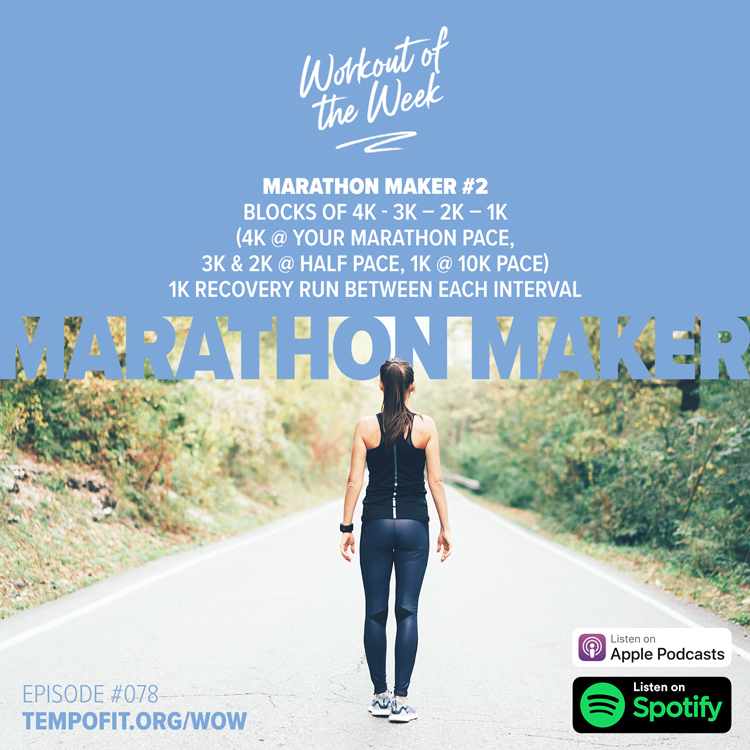
Now in week two of our Marathon Maker series we’re introducing the first our marathon-paced blocks. Plus, we’re upping the distance and the endurance factor so give this workout a little more time.
WHAT?
Marathon Maker #2
4k – 3k – 2k – 1k (4k @ your marathon pace, 3k & 2k @ your half marathon pace, 1k @ 10k pace)
1k recovery run between each interval
Terrain: Flat, measurable pathway.
To continue our Marathon Maker series, this week we’re adding in the 4k block and marathon pace and, because of the longer distances, we’re slowing down the 2k block to your half marathon pace.
Remember, we’re keeping the recovery runs in the upper end of your easy range—about 30secs per km slower than your marathon pace.
WHY?
When you’re running a marathon, aside from doing the base work of developing great aerobic fitness and preparing the body to go long, you’ve got to also put in the miles at your goal race pace.
This is important because it trains the mechanics of that pace (so your muscles and nervous system are well adapted to that range of motion and power output), it improves your pace judgement (more on that below), and it helps for practicing things like nutrition and hydration (which is notoriously difficult the faster you’re running!).
HOW?
Notice that both the 3k and 2k blocks are at half marathon pace (as opposed to last week where both the 2k and the 1k were at 10k pace). This allows us to add more distance to the workout as we get up to 10k worth of work, plus the recoveries and warm ups and warm downs.
THOUGHTS FOR THE WEEK:
HOW TO PACE A MARATHON
One of the most important things you can do when running a marathon (or any similar endurance event), aside from actual running training, is to pace yourself brilliantly. Running even splits (or slightly negative) is the proven way to get the absolute most from your performances.
And here are my top five techniques on how to develop great marathon pacing:
- Practice the Pace: Kinda goes without saying, but it’s important to say it because many training plans polarise the training speeds with plenty of slow aerobic running and a good amount of faster running (faster than one-hour race pace) but not much in-between. This is for good reason as it reduces injury risks while being sure to maximise both aerobic development and mechanical efficiencies, but at some point you need to practice race pace and have this locked into your muscle memory—learn what it feels like, pay attention to cadence and range of motion, feel the breathing rate and fatigue demands.
- Don’t Just Watch Your Watch: The speed your GPS watch is giving is useful but it can vary depending on satellite connections and interferences from trees and buildings. So it’s important also to use KM or mile markers on the course and to remember what splits your looking for (a little maths here goes a long way!).
- “If it doesn’t feel slow, you’re going too fast.” This is one of the greatest truism is marathon coaching. You need to feel well within yourself at least for the first 13-14k, because it will catch up on you. Guaranteed!
- 200m Checks: If you want to really geek out I’ll let you in on a secret I’ve done with myself and the runners I coach. If I can access the course the day before, I’ll physically wheel out a couple of exact 200m zones (this could be from the start line or another flat section of the course) and we use these markings in the early stages of the race to get highly accurate speed readings (e.g. if my goal pace is 4min/km, I know I need to hit 48 seconds for every 200m).
- Cross Reference: With all these check points of GPS pace, mile marker splits, knowing it needs to feel comfortable and slow at the start, and even geeked out 200m checks, you combine all this data and create a really wonderful picture for just how hard and fast you’re working to make sure you’re not burning any more matches than are needed.
Podcast (workout-of-the-week): Play in new window | Download
Subscribe: Apple Podcasts | RSS | More



